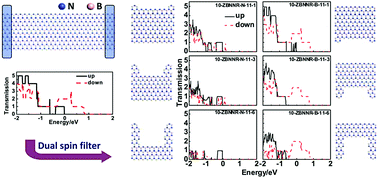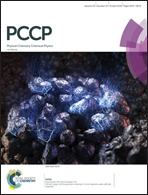Edge defect switched dual spin filter in zigzag hexagonal boron nitride nanoribbons†
Abstract
Unlike graphene nanoribbons, zigzag monolayer hexagonal boron nitride nanoribbons (ZBNNRs) possess two distinct edges (B and N edges). Using first-principles calculations, we investigate the spin-dependent electronic transport of ZBNNRs with edge defects. It is found that the defects could make the system operate as a dual spin filter, where the direction of spin polarization is switched by the defect. Further analysis shows that the transmission eigenchannels for the opposite spins reside spatially separated on opposite edges. The defect on one edge could suppress the transmission for only one spin component, but preserve that for the other spin, resulting in a dual spin filter effect. This effect is found to be unaffected by the width of the ribbon and the length of the defect. Moreover, by constructing defects on both edges, the system exhibits two transmission peaks with opposite spins residing discretely on both sides of the Fermi level, suggesting that an electrically controlled dual spin filter based on ZBNNRs is also realizable. As controllable defects have been experimentally fabricated on monolayer boron nitride [T. Pham, A. L. Gibb, Z. Li, S. M. Gilbert, C. Song, S. G. Louie and A. Zettl, Nano Lett., 2016, 16, 7142–7147], our results may shed light on the development of B/N-based spintronic devices.



 Please wait while we load your content...
Please wait while we load your content...